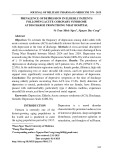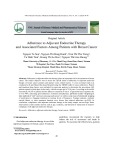
THAI BINH JOURNAL OF MEDICAL AND PHARMACY, VOLUME 16, ISSUE 2 - MARCH 2025
10
PREVALENCE AND FACTORS ASSOCIATED WITH OVERWEIGHT
AND OBESITY AMONG ADULTS IN THAI BINH PROVINCE IN 2024
1. Thai Binh University of Medicine and Pharmacy
2. Thai Binh Demartology Hospital
3. Thai Binh Center for Disease Control
4. Thai Binh Medical College
*Corresponding author: Pham Thi Van Anh
Email: phamanh.nihe@gmail.com
Received date: 10/2/2025
Revised date: 10/3/2025
Accepted date: 15/3/2025
Vũ Phong Tuc1, Tran Thai Ha², Pham Thi Van Anh³*,
Nguyen Thanh Son⁴
ABSTRACT
Objective: To determine the prevalence of
overweight and obesity and identify associated
factors among adults in Thai Binh Province in 2024.
Subjects and Methods: A cross-sectional
study was conducted on 1,330 adults across 8
districts/cities in Thai Binh Province from June to
July 2024. Data were collected via anthropometric
measurements, interviews, and blood tests,
analyzed using logistic regression
Results: The prevalence of overweight and
obesity was 49.4%, with 28.0% at risk, 19.2%
overweight, and 2.2% obese. Associated factors
included body fat (OR=1.14, 95% CI: 1.12-
1.16), visceral fat (OR=1.92, 95% CI: 1.79-2.06),
alcohol consumption (OR=1.54, 95% CI: 1.16-
2.05), beer consumption (OR=1.63, 95% CI:
1.23-2.16), and fruit intake (OR=0.93, 95% CI:
0.88-0.98). Additionally, 30.5% had increased
waist circumference, 33.2% had a high waist-to-
hip ratio, 50.3% had high/borderline cholesterol,
and 66.0% had high/very high triglycerides.
Conclusion: Overweight and obesity affect nearly
half of adults in Thai Binh, linked to body fat,
visceral fat, alcohol/beer consumption, and low fruit
intake, necessitating targeted interventions.
Keywords: Overweight, obesity, associated
factors, Thai Binh
I. INTRODUCTION
Overweight and obesity, characterized by
excessive fat accumulation, are major risk factors
for cardiovascular diseases, type 2 diabetes, and
metabolic syndrome. Globally, their prevalence
has surged, particularly in developing nations
like Vietnam, driven by urbanization, sedentary
lifestyles, and dietary shifts (1). The World Health
Organization (WHO) reported that worldwide
obesity has nearly tripled since 1975, affecting over
1 billion people by 2022, including 650 million adults,
340 million adolescents, and 39 million children
(2). On World Obesity Day 2022, WHO highlighted
that this number continues to rise, projecting
an additional 167 million people will face health
consequences from overweight or obesity by 2025.
Obesity impacts most body systems, increasing
risks of noncommunicable diseases (NCDs) such
as hypertension, stroke, and cancers, and tripling
the likelihood of hospitalization for COVID-19 (2).
In Vietnam, the prevalence of overweight and
obesity among adults escalated from 15.6% in 2015
to 26.8% in urban areas and 18.3% in rural areas
by 2020, according to the Ministry of Health (3).
The World Obesity Atlas 2023 forecasts an annual
increase of 6.2% for adults and 9.8% for children,
among the highest globally, with an economic
burden projected to reach 2.0% of national GDP by
2035 due to healthcare costs and lost productivity
(4). In Thai Binh Province, a Red River Delta region
undergoing rapid socioeconomic transition, these
trends may be amplified, in 2019 the proportion of
individuals aged 25-64 with a BMI greater than or
equal to 25 was 11.8% (5). Amid this crisis, WHO’s
World Obesity Day 2022 call to accelerate action
underscores the need for early intervention (2).
This study aims to assess the current prevalence of
overweight and obesity among adults in Thai Binh
in 2024 and identify associated factors to inform
public health strategies.
II. SUBJECTS AND METHODS
2.1. Subjects, Location, and Study Period
The study included 1,330 adults from 8 districts/
cities in Thai Binh Province: Thai Binh City (De
Tham, Dong My, Phu Xuan), Vu Thu (Viet Hung,
Minh Lang), Dong Hung (Phong Chau, Phu Luong),
Tien Hai (An Ninh, Phuong Cong), Quynh Phu (An
Hiep), Thai Thuy (Hoa An), Hung Ha (Hong Minh),
and Kien Xuong (Tay Son).
Data collection occurred over a two-month period,
from June to July 2024, a time frame selected to
avoid seasonal variations in diet or physical activity
that might occur during harvest or festive periods.
Inclusion criteria required participants to be adults

























